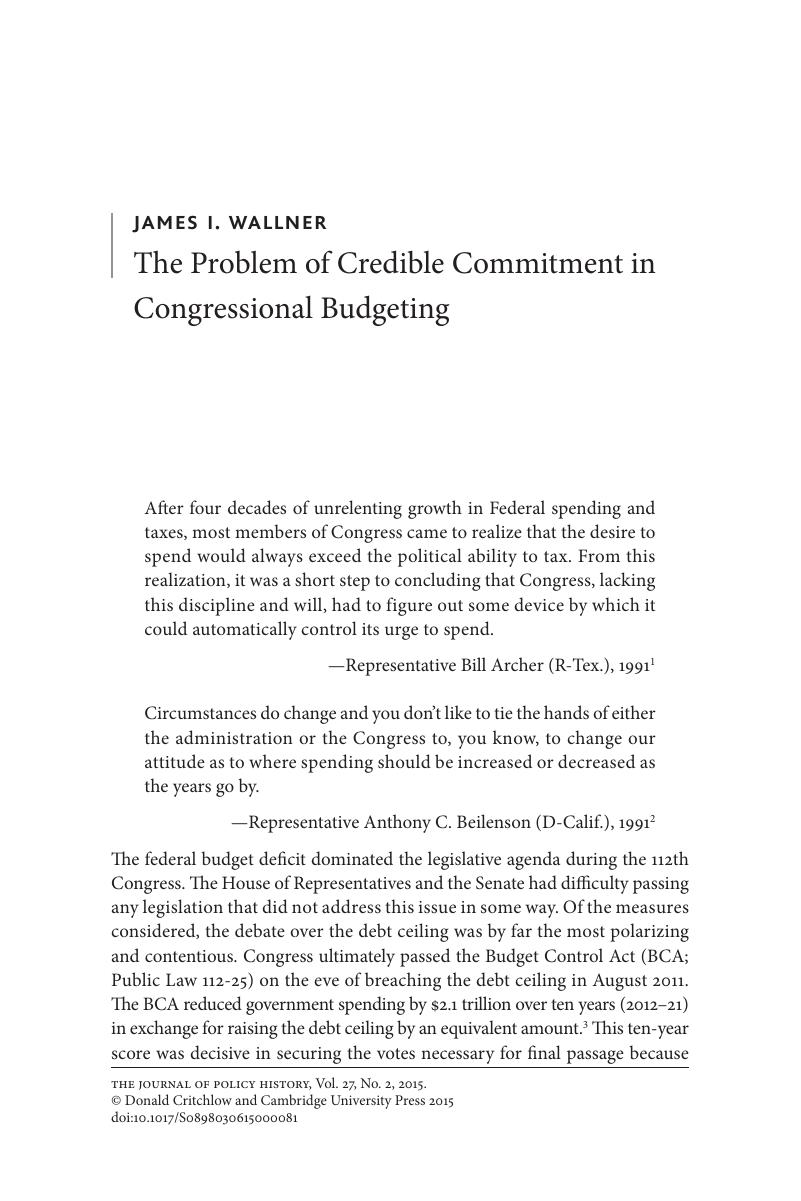Published online by Cambridge University Press: 02 March 2015

1. Cong. Rec. H6,337 (1991).
2. Mid-Session Review of the Fiscal Year 1992 Budget: Hearing before the House Committee on the Budget, 102nd Cong., 1st sess. 11 (1991).
3. All of the spending totals in this article represent budget authority instead of budget outlays. Budget authority is a more accurate measurement of federal obligations because it captures all of the financial obligations that the government may occur, which by definition includes all outlays regardless of their spend-out rate. Unless otherwise indicated, all years referred to in this article are fiscal years.
4. The BEA was included as Title XIII of the Omnibus Budget Reconciliation Act of 1990. It was extended as part of the Omnibus Budget Reconciliation Act of 1993 (Public Law 103-66) and again a few years later in the Balanced Budget Act of 1997 (Public Law 105-33). The BEA expired in 2002.
5. The foregoing analysis is based on several reports from the Congressional Budget Office, including Emergency Spending under the Budget Enforcement Act, Washington, D.C., 1998; Emergency Spending under the Budget Enforcement Act: An Update, Washington, D.C., 1999; The Budget and Economic Outlook: Fiscal Years 2004–14, Washington, D.C., 2003; and Final Sequestration Report for Fiscal Year 2013, Washington, D.C., 2013.
6. North, Douglas C. and Weingast, Barry R., “Constitutions and Commitment: The Evolution of Institutional Governing Public Choice in Seventeenth-Century England,” Journal of Economic History 49, no. 4 (1989): 803–32.CrossRefGoogle Scholar
7. Ibid., 804; Miller, Gary J., Managerial Dilemmas: The Political Economy of Hierarchy (New York, 1992), 255.CrossRefGoogle Scholar
8. Dauster, William G., “Budget Emergencies,” Journal of Legislation 18, no. 2 (1992): 249–315.Google Scholar
9. The Balanced Budget and Emergency Deficit Control Act of 1985 (Gramm-Rudman; Public Law 99-177) was designed to serve as a catalyst for future deficit reduction. It established annual deficit targets. Deficits that exceeded the targets set forth in the statute would be automatically reduced by an across-the-board sequestration procedure to cut spending. However, Gramm-Rudman was ineffective in reducing the deficit. It was unworkable in that the deficit targets were not explicitly linked to a broader political agreement on the policies needed to achieve them. In addition, the size of the deficit was exacerbated by lower than expected economic growth in the late 1980s. The deficit targets in Gramm-Rudman were revised and extended in 1987 in the Balanced Budget and Emergency Deficit Control Reaffirmation Act of 1987 (Public Law 100-119).
10. In addition to emergency appropriations, the BEA permitted cap adjustments for changes in budgetary concepts and definitions, changes in inflation, specified allowances for particular spending, such as Social Security disability reviews, and funding for the International Monetary Fund.
11. In addition to an emergency exception, the BCA also exempted spending designated for the wars in Iraq and Afghanistan, as well as spending specifically for disaster relief under the Robert T. Stafford Disaster Relief and Emergency Assistance Act from the discretionary caps. In addition to these exceptions, the BCA permitted cap adjustments for changes in budgetary concepts and definitions, specified allowances for particular spending such as Social Security disability reviews, and program integrity measures to combat health-care fraud and abuse.
12. This point is underscored by the fact that the average amount of spending in excess of the BEA’s caps was significantly higher when Republicans, a party ostensibly in support of lower levels of government spending, was in control of the House and Senate.
13. Spending on operations Desert Shield and Desert Storm were not counted against the BEA’s caps because they were specifically exempted in statute. This spending was also omitted from the emergency totals for 1991 and 1992 because it was fully offset by foreign contributions from allied nations.
14. Cong. Rec. S11,754 (1991) (statement of Sen. Baucus).
15. Cong. Rec. H6,337 (1991) (statement of Rep. Rostenkowski).
16. Cong. Rec. S11,748 (1991) (statement of Sen. Domenici).
17. Cong. Rec. H6,337 (1991) (statement of Rep. Archer).
18. The emergency exception will continue to be used for legitimate emergencies as well. Legitimate uses during this period included the Los Angeles riots and Hurricane Andrew in 1992, Midwest flooding in 1993, and the Oklahoma City bombing in 1995. Some attribute the higher emergency spending levels to the increase in disasters during the 1990s. However, the increase in emergency spending over the period cannot be totally accounted for by examining natural disasters and terrorist attacks only.
19. Quoted in Morgan, Iwan, The Age of Deficits: Presidents and Unbalanced Budgets from Jimmy Carter to George W. Bush (Lawrence, Kans., 2009), 201.Google Scholar
20. Annual emergency spending for LIHEAP began in 1992. Annual emergency spending for the Forest Service and the Department of the Interior began in 1993.
21. Morgan, , The Age of Deficits, 202Google Scholar.